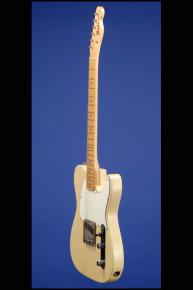A Maple-Cap Esquire
This lightweight blond beauty weighs just 6.50 lbs. and has a nut width of 1 5/8 inches and a scale length of 25 1/2 inches. Solid ash body and super rare maple-cap neck with a wonderful medium-to-fat profile. Maple-cap fretboard with 21 original medium-thin frets and black dot position markers. Single "butterfly" string tree. CBS 'Black' headstock decal with "Fender Esquire" and two patent numbers "2,573,254 3,143,028" in black below it. Individual Fender "F" Tuners with octagonal metal buttons. Four-bolt neck plate with serial number "252319" between the top two screws.One single-coil pickup, angled in bridgeplate, with an output of 6.06k. Three-ply (white/black/mother-of-toilet-seat) plastic pickguard with eight screws. Two controls (one volume, one tone) plus three-way "tone" switch with "top-hat" tip, all on metal plate adjoining pickguard. Chrome knobs with flat tops and knurled sides. Telecaster/Esquire combined bridge/tailpiece with three steel saddles. Complete with its original "ashtray" bridge cover. The neck is stamped "3OCT68A", and the pots are dated "137 6642" (CTS, October 1966). Apart from a few small surface marks on the edges, and some finish checking, this remarkable example of a very rare maple-cap Esquire is in totally original and exceptionally fine (9.00) condition. Complete with it's original 'Ashtray' bridge cover, original Fender 12 page hang-tag Instruction manual, guitar cord, guitar strap and an old set of Fender strings. Housed in its original Fender black hardshell case with orange plush lining (9.25).
This is the first 'maple-cap' Esquire that we have ever seen!
The price in July 1968 was $194.50 for the guitar (a full $35.00 less than its Telecaster cousin)... plus a huge $57.50 for the case!
"Leo Fender's new solidbody was the instrument that we know now as the Fender Telecaster, effectively the world's first commercially successful solidbody electric guitar...The guitar was originally named the Fender Esquire and then the Fender Broadcaster, and it first went into production in 1950. It was a simple, effective instrument. It had a basic, single-cutaway, solid slab of ash for a body, with a screwed-on maple neck. Everything was geared to easy production. It had a slanted pickup mounted into a steel bridge-plate carrying three adjustable bridge-saddles, and the body was finished in a yellowish color known as blond. It was unadorned and like nothing else. It was ahead of its time (Tony Bacon, 50 Years of Fender, p. 10).
"After a false start the Esquire re-appeared...in 1951, now with Fender's new adjustable truss-rod. It was offered in single-pickup format only, but otherwise was virtually identical to the two-pickup Telecaster. However, the Esquire's three-way selector functioned as a preset tone control or bypass switch, offering wide versatility from a one-pickup guitar. Perhaps surprisingly, the Esquire stayed in the line for 20 years" (Tony Bacon and Paul Day, The Fender Book, p. 10).
Translate:














